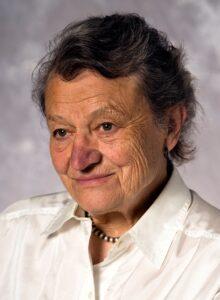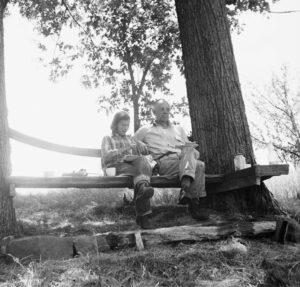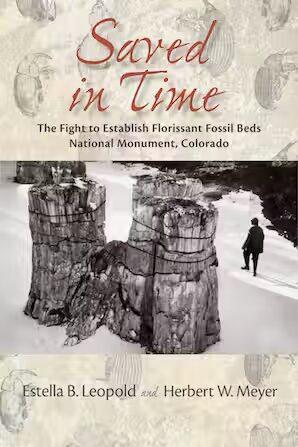Remembering Estella Leopold
and Her Defense of the Eocene
Environmental historian Char Miller has shared his reflections on the conservation work of Estella Bergere Leopold, the prominent paleoecologist and conservationist, who died on February 25, 2024, at age 97.

Some 34 million years ago, a butterfly died. It was a nymphalid, today the largest family of butterflies (and perhaps then, too). Paleontologists do not know how or why it perished, but that it lived is perfectly preserved in the geologic record.
More exactly, its fossilized remains were entombed in paper shale that has risen to the surface at what is now the Florissant Fossil Beds National Monument in Colorado. Once a shallow lake surrounded by groves of redwoods and broad-leafed trees, a fecund home to a vibrant biota, the now-grassy site was buried in ash and lava flows from the once-volcanic mountains nearby. Over time, wind and erosion have swept away layers of this thick, pressurized coating: Large silicified redwood trunks silently testify to the powerful natural forces that have transformed this terrain. The weathered, gray-black sheets of shale—and the paper-thin fossils embedded within them—bear witness to ancient life on Earth.
This testimony is perhaps best captured in the excited prose of geologist Arthur C. Peale, who encountered the landscape in 1873: “When the mountains are overthrown and the seas uplifted, the universe at Florissant flings itself against a gnat and preserves it.”

Artist's reconstruction of the fossil butterfly Prodryas persephone based on the related genera Hypanartia and Antanartia. (Franz Anthony, https://commons.wikimedia.org/wiki/File:Prodryas_persephone.jpg)
Unearthing this deep past of butterflies and gnats, fish, pollen, and tree trunks, all dazzling markers of the Eocene Epoch, began in the nineteenth-century as homesteaders arrived in the area, some 30 miles outside of present-day Colorado Springs. In the 1870s, one of them—Charlotte Hill—peeled back a layer of shale and spotted a perfectly preserved fossil of a long-extinct butterfly, Prodryas persephone. Like the specimen’s mythic namesake, Hill’s discovery was immensely generative, rocking the scientific world of her day.
A century later it still had the capacity to shake things up: In the 1960s the site was at the center of a sharp political debate pitting developers against an increasingly savvy group of preservationists and paleontologists. Those who wished to build upcountry chalets battled in the courts, Congress, and the media against those who wanted the federal government, through the good offices of the National Park Service, to protect this spectacularly unique remnant of a distant time. For the proponents of the fossil beds, the long-dead butterfly still had wings.
We know the final outcome: On August 20, 1969, after a bruising struggle that had more twists and turns than any switch-backed trail up nearby Pike’s Peak, President Richard Nixon signed legislation to “preserve and interpret for the benefit and enjoyment of present and future generations the excellently preserved insect and leaf fossils and related geologic sites and objects” (Public Law 91-60). In doing so, he granted national-monument status to a place some have touted as the Rosetta Stone of North American paleontology.
Deciphering the tense maneuvering during the years and months that proceeded the White House signing ceremony is Saved in Time: The Fight to Establish Florissant Fossil Beds National Monument, Colorado (2012), a brilliant and collaborative project of Estella Leopold and Herbert Meyer. Leopold was a gifted paleoecologist and one of Aldo Leopold’s remarkable progeny.1 And her obituaries rightly lauded her remarkable career as a scientist and activist, and her manifold ability to write with narrative force and insight. Her Stories from the Leopold Shack (2016), a graceful, intimate, and familial memoir, puts her in close conversation with her late parents, Estella and Aldo Leopold, and their ecological commitments to restore their once-battered land in Wisconsin.

Estella Leopold with her father Aldo, at the Shack, 1937. (Photos courtesy of the Aldo Leopold Foundation)
My favorite of her recent books, however, is Saved in Time, precisely because it is more public-facing, more revelatory of the complicated actions needed to protect and preserve the deep past. Leopold and her allies never doubted the Florissant fossil beds’ vital importance. The issue was how to convinced others of their inestimable value. As so often happened in conservation battles of the 1950s and 1960s, the issues were quickly framed as a struggle between the scientific and cultural claims of the place and those of economic growth and development.
Like their contemporaries who fought against the construction of dams on free-flowing rivers or clear-cutting of the national forests, and like their urban counterparts valiantly trying to block highways from blasting through historic neighborhoods and open space, the Defenders of Florissant—a grassroots organization that Leopold helped to establish—faced insurmountable odds.
The explosive economy of the postwar years, echoed in the demographic spike of the Baby Boom, privileged the arguments of those who promised to provide essential energy and other natural resources, to generate jobs and build homes. That ethos prevailed in small towns and major cities, in the civic arena, in politics and the law. To run against this American grain, to stop the bulldozers in their tracks, required an astonishing level of commitment and conviction.
Even then, conservationists did not always succeed. Growth for growth’s sake, then as now, has a tenacious hold on the polity. So although scientists such as Estella Leopold and Beatrice Willard made an irrefutable case for the paleontological significance of Florissant, their arguments required the creation of a grassroots movement that would build an effective network of well-placed supporters in Colorado and across the nation. Their achievement depended as well on a team of skilled lawyers willing to work for a pittance to argue nonstop before judges local, state, and federal. They had the good fortune that their hue and cry was picked up by an emerging environmental movement and a sympathetic congress then in the midst of promoting a series of initiatives, starting with the Wilderness Act of 1964; it legitimized the idea that some pristine terrain was inviolable.
 This broader cultural shift emboldened lawyers such as Richard Lamm, who was active on the Florissant lawsuits, and who later became governor of Colorado: He and his peers “recognized that the laws were changing,” Leopold and Meyer write. “It was really apparent by this time that there was going to be a whole new rethinking of the human role in the environment.” In that ferment, Lamm reasoned, this particular case “was a risk worth taking.”
This broader cultural shift emboldened lawyers such as Richard Lamm, who was active on the Florissant lawsuits, and who later became governor of Colorado: He and his peers “recognized that the laws were changing,” Leopold and Meyer write. “It was really apparent by this time that there was going to be a whole new rethinking of the human role in the environment.” In that ferment, Lamm reasoned, this particular case “was a risk worth taking.”
However galvanizing the rhetoric proved to be, and as a rallying force it cannot be denied, the Wilderness Act was aimed at public-lands management. Had the Florissant fossil beds been on the public domain, the creation of the eponymous national monument would have been relatively straightforward. But they were located on private property, a status that intensified the legal pressure: Urging the judiciary to prohibit owners from developing their land as they saw fit has never been an easy sell.
Surmounting that obstacle required a multifaceted attack. The Defenders of Florissant repeatedly went to court to delay developers eager to despoil the fossil beds for a housing subdivision, buying time so that its congressional allies could pass enabling legislation for the proposed national monument and the necessary money to purchase relevant acreage from willing sellers.
Yet when the courts dawdled and congress fiddled, and the builders fired up the bulldozers to take matters in their own hands, activists had to get down and dirty, flinging their bodies in front of the earth-moving equipment. As the drivers pulled backed, the lawyers once more hustled into the courthouse.
The Defenders’ legal team proved particularly adept at innovative pleadings. Most potent was its final gambit: They argued in federal court in July 1969 that the proposed “Florissant Monument is a national resource treasure,” and that the “sovereign people of the United States” had a right to enjoy the fossil beds’ “unique value,” a right guaranteed under what attorney Victor Yannacone called the Public Trust Doctrine.
The doctrine dates back to the colonial era during which the British crown decreed that it had an obligation to protect resources for public benefit. It would later find republican expression in the Ninth Amendment to the U.S. Constitution: “The enumeration in the Constitution, of certain rights, shall not be construed to deny or disparage others retained by the people.”
At least that’s how Yannacone parsed that text’s arcane language, asserting boldly (and without precedent) that among the unenumerated rights this amendment protected is that of the people’s to “the full benefit, use, and enjoyment of an irreplaceable natural resource.”
Punctuating his assertion with a bit of John Muir–like hyperbole, Yannacone assured the courtroom that to “sacrifice this 34-million-year-old record, a record you might say written by the mighty hand of God, for 30-year mortgages and the basements of A-frame ghettos of the Seventies is like wrapping fish with the Dead Sea Scrolls.”
In the end, the federal court and Congress moved with just enough dispatch to preserve the land and its ancient artifacts. Saved in Time rightly concludes with the enumeration of the herculean and painstaking efforts of Leopold’s coauthor, paleontologist Herbert Meyer, to piece together the local fossil record. Although cataloguing and publishing a portion of the 35,000 specimens from Florissant now lodged in museums around the world may be less dramatic than the cliffhanger campaign to defend the imperiled site, it has been no less critical.
Without this voluminous evidence we’d have no real appreciation for just how important it was that one day, 34 million years ago, a butterfly died.
About the author: Char Miller is the W. M. Keck Professor of Environmental Analysis and History at Pomona College. He is author of Natural Consequences: Intimate Essays for a Planet in Peril (2022) and the forthcoming Burn Scars: From Colonial Suppression to the Resurgence of Cultural Burning. A different version of this essay appeared in Miller’s Not So Golden State: Sustainability vs. the California Dream.
1. For a more complete biography of Leopold, see Susan Flader, “Estella Bergere Leopold: Paleoecologist and Conservationist,” Forest History Today, Spring/Fall 2010, 55-57.

